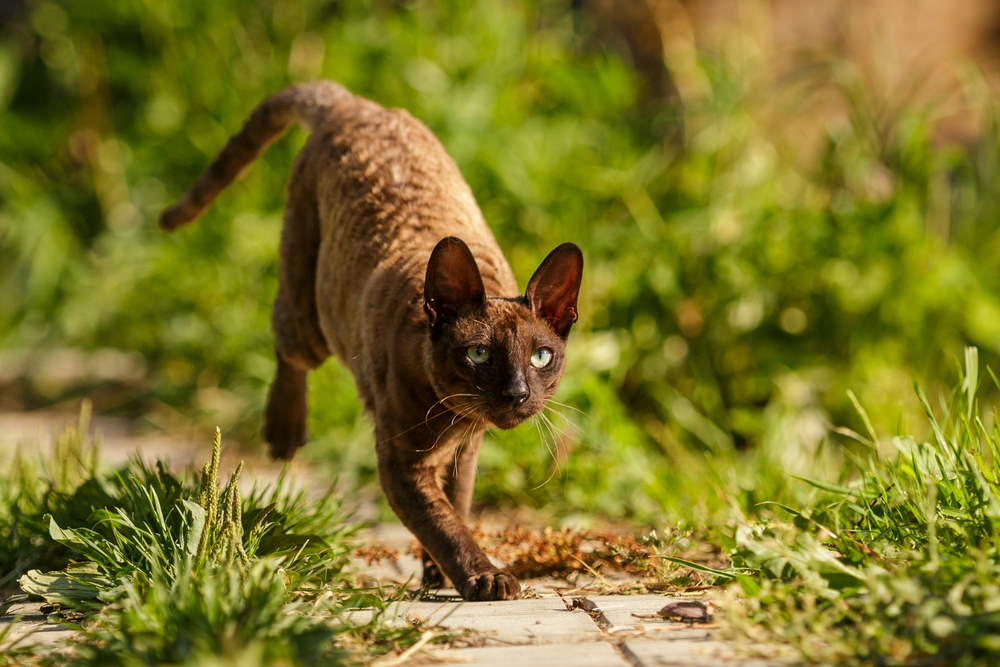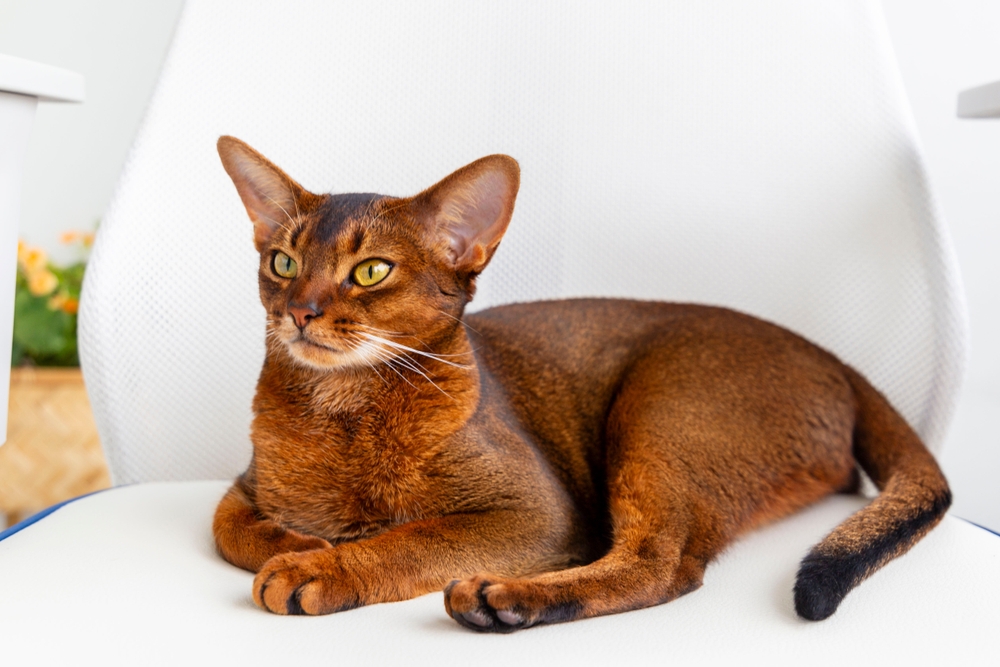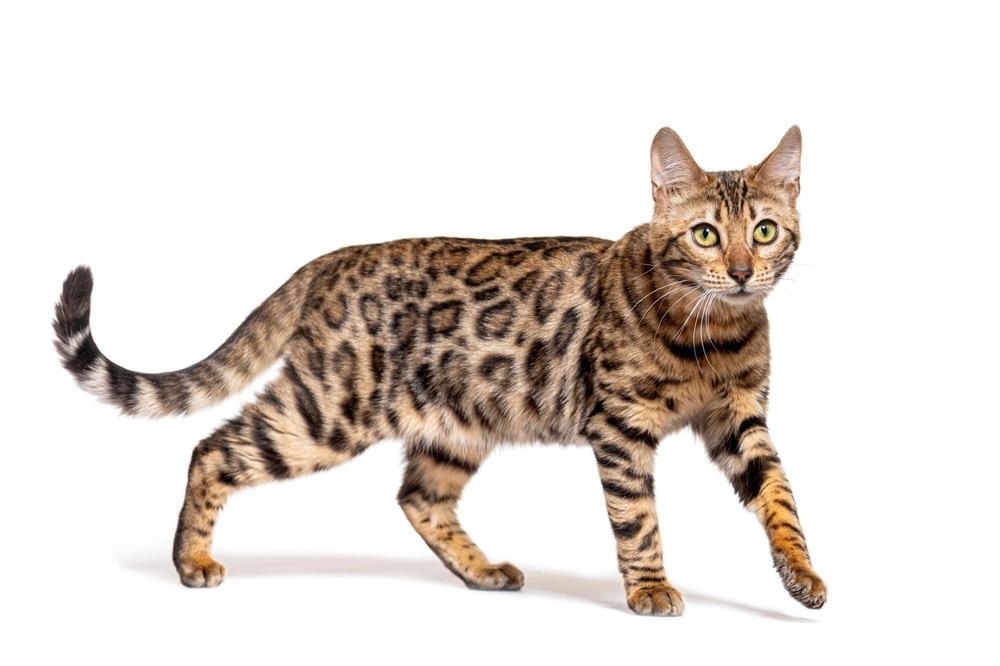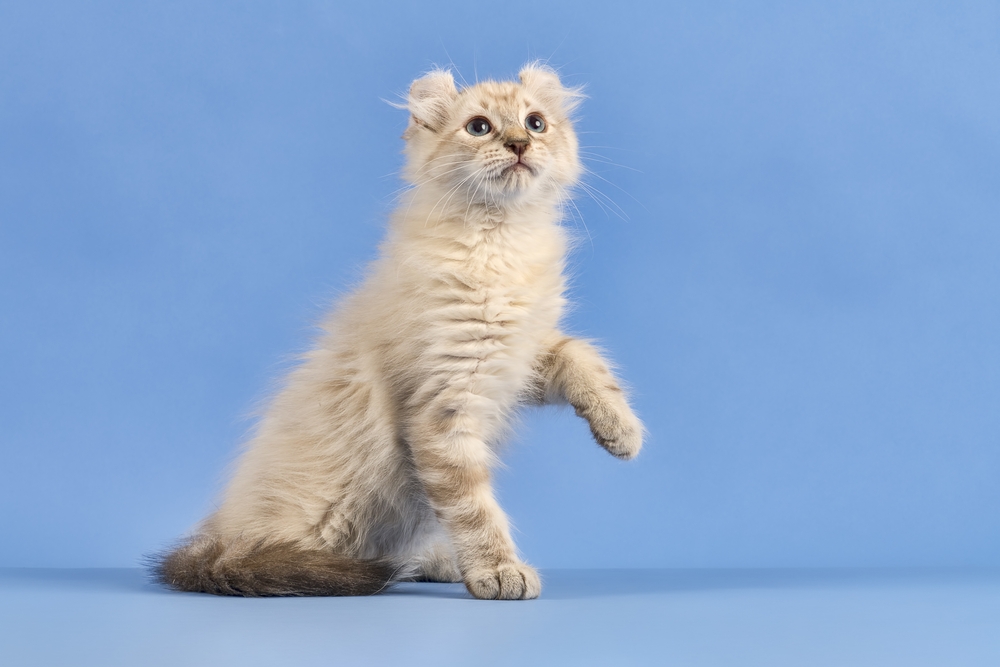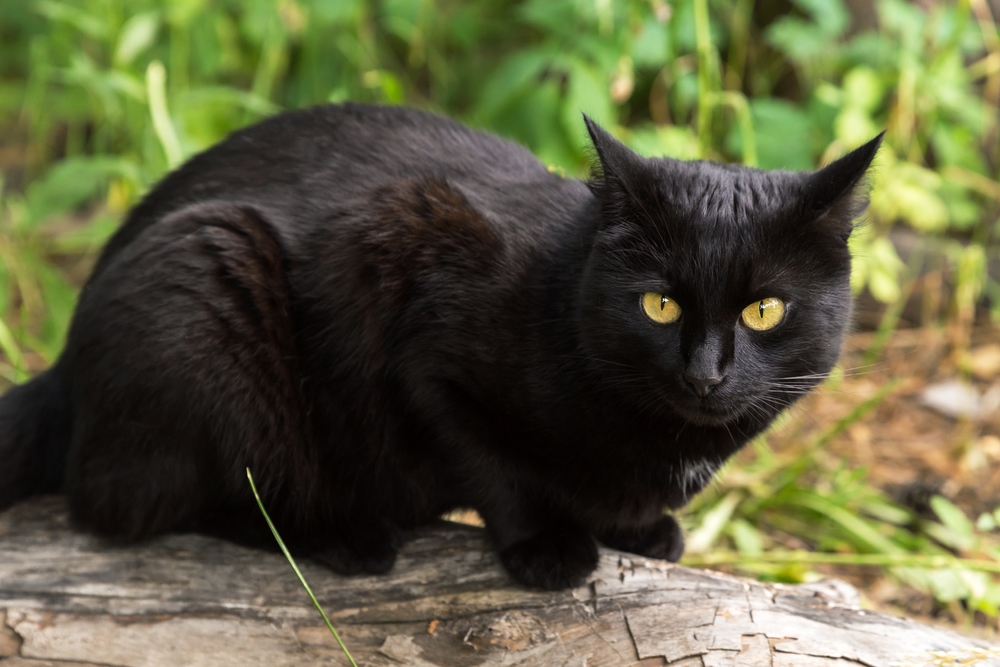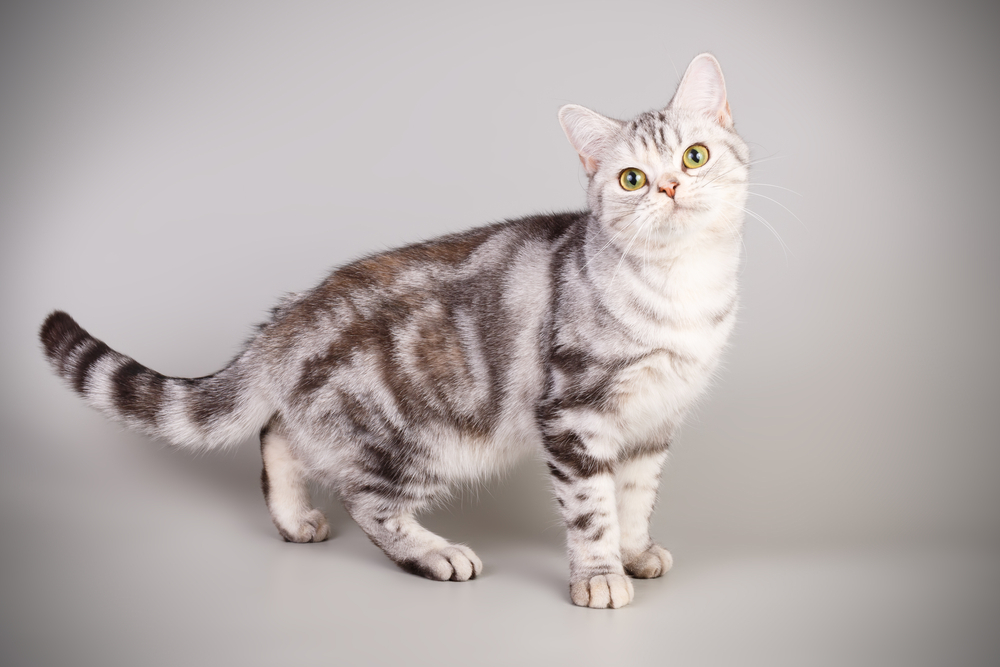The Cornish Rex is most closely related to other curly-coated breeds, particularly the Devon Rex, which also has large ears and a soft coat but differs genetically. The Selkirk Rex and LaPerm share the curly trait, though their fur is fuller and less sleek than the Cornish Rex’s rippled waves.
About
The Cornish Rex is one of the most distinctive and elegant cat breeds, renowned for its unique curly coat and refined build. Unlike most cats, which have three layers of fur, the Cornish Rex has only the soft undercoat, known as down hair. This gives the coat its signature rippled, velvety texture that feels like crushed silk. Sleek and slender, the Cornish Rex has a fine-boned body, long legs, a tucked waist, and large bat-like ears perched atop an egg-shaped head, giving it a strikingly modern, almost alien appearance.
The Cornish Rex (Felis catus), of the family Felidae, originated in Cornwall, England, in 1950. A kitten with an unusual curly coat, named Kallibunker, was born to a barn cat. Breeders preserved this natural genetic mutation through selective breeding, crossing it with domestic shorthairs, Siamese, and other breeds to maintain health and structure. Today, the Cornish Rex is celebrated worldwide for its beauty and playful spirit.
Weighing between 6–10 pounds (2.7–4.5 kg), the Cornish Rex is light but muscular and built for agility. Despite its delicate appearance, it is athletic, fast, and capable of impressive jumps. The breed is famously playful and often described as “kitten-like” throughout its life. Intelligent, curious, and affectionate, Cornish Rex cats thrive on interaction, often following their humans around, fetching toys, or perching on shoulders.
Their coats require little grooming, as they shed minimally, though they can be sensitive to temperature due to their fine fur. They prefer warm environments and often seek cozy spots or laps for comfort.
With their velvety coats, boundless energy, and affectionate nature, Cornish Rex cats are both elegant and entertaining companions, bringing endless joy to active, engaging households.
Physical Characteristics
Coat: The Cornish Rex is instantly recognizable for its short, soft, and wavy coat. Unlike most cats, they lack guard hairs, leaving only the down hairs, which creates a silky, velvety feel. The waves, known as “marcel waves,” ripple across the body in tight curls. The coat can appear in nearly all colors and patterns, including solid, tabby, bicolor, and pointed.
Face: They have a distinctive “egg-shaped” head with high cheekbones, a Roman nose (slight curve), and large, oval eyes that give them a lively, alert expression. Eye color varies depending on coat color.
Body: The Cornish Rex has a slender, elegant, and whippet-like build with a deep chest, long fine-boned legs, and a tucked-up waist. Despite their delicate appearance, they are muscular and agile.
Ears: Large, high-set, and prominent, often described as “bat-like,” giving the breed an alert, curious look.
Tail: Long, thin, and whip-like, covered with the same soft, wavy fur as the body.
Size:
-
Length: 12–16 in (30–41 cm) from head to base of tail.
-
Height: 10–12 in (25–30 cm) at the shoulder.
Weight:
-
Adult Female: 5–7 lbs (2.3–3.2 kg).
-
Adult Male: 6–9 lbs (2.7–4.1 kg).
The Cornish Rex’s combination of a rippled coat, slender athletic body, and large ears gives it one of the most unusual and elegant appearances in the cat world, often compared to a miniature racehorse or greyhound.
Reproduction
Mating and Courtship:
Cornish Rex cats usually reach sexual maturity between 6–9 months of age, though ethical breeders often wait until at least 12 months to ensure proper growth before breeding. Females in heat exhibit typical signs—restlessness, rolling, loud vocalizations, and rubbing behavior. Males respond with vocal calls and persistent pursuit.
Breeding Season:
They can breed year-round, but queens often cycle more regularly in spring and summer when daylight hours are longer.
Gestation:
The gestation period lasts about 63–65 days (around 9 weeks).
Birth of Kittens:
Typical litter size is 3–6 kittens, though litters may range from 1 to 7. Kittens are born with the characteristic short coat, but the full curl pattern develops as they grow.
Care and Nurturing:
Kittens are born weighing around 3–4 oz (85–113 g), blind, and completely dependent on the mother. Cornish Rex queens are generally attentive mothers, providing warmth, grooming, and nursing.
Weaning and Social Development:
-
Eyes open at 7–10 days.
-
Kittens begin walking around 3 weeks.
-
Solid food is introduced by 4–5 weeks, with full weaning at 8–10 weeks.
-
The wavy coat becomes more defined as kittens mature, usually noticeable by 3–4 months.
Independence:
By 12–14 weeks, kittens are ready for adoption, having developed social skills, litter training, and playful curiosity. Breeders typically keep them until at least 12 weeks to ensure proper growth and emotional development.
The Cornish Rex’s reproductive cycle mirrors that of most domestic cats, but their kittens’ coat development is especially unique, with the distinctive rippled fur becoming more pronounced as they mature.
Lifespan
Lifespan in the Home:
Cornish Rex cats generally live 12–16 years, with many reaching 17–20 years when cared for properly. Their slender build and active nature contribute to long, healthy lives.
Lifespan in Outdoor or High-Risk Settings:
Because they have little protection from the elements due to their fine coat, outdoor Cornish Rex cats face higher risks from cold, heat, predators, and disease. In such conditions, lifespans may be shortened to 6–10 years.
Factors Affecting Longevity:
-
Genetics: The breed is generally healthy but can be predisposed to hypertrophic cardiomyopathy (HCM), patellar luxation, and some dental issues.
-
Diet & Exercise: A protein-rich diet and regular interactive play help maintain muscle tone and prevent obesity.
-
Preventive Care: Routine veterinary checkups, vaccinations, and dental hygiene extend lifespan and quality of life.
-
Environment: Cornish Rex cats do best as indoor pets with enrichment (cat trees, climbing posts, toys), since their delicate coat doesn’t provide much insulation.
Notable Longevity:
Some Cornish Rex cats have been documented living 18–20+ years, particularly in stable, loving homes with consistent health care.
The Cornish Rex’s combination of elegance, energy, and robust health—when paired with attentive care—makes it a long-lived breed that often enjoys many active senior years.
Eating Habits
Diet:
Cornish Rex cats are obligate carnivores and require a high-protein, meat-based diet to support their lean, muscular build and active metabolism. Premium commercial cat food—wet, dry, or a balanced combination—works well, though wet food is especially beneficial for hydration and urinary health.
Feeding Frequency:
-
Kittens (up to 6 months): 3–4 meals per day to fuel rapid growth and boundless energy.
-
Adults (6 months–10 years): 2–3 meals daily, portioned to maintain a lean frame.
-
Seniors (10+ years): Smaller, more frequent meals or senior formulas to support kidney and joint health.
Special Considerations:
-
Cornish Rex cats have fast metabolisms, and many require slightly larger portions than other breeds of similar size.
-
Because of their high energy, they burn calories quickly, but portion control is still important to avoid overeating.
-
Fresh water should always be available, as hydration supports kidney and overall health.
Treats:
Healthy treats like freeze-dried meat, cooked poultry, or small commercial cat treats are suitable, but should remain under 10% of daily calories.
Feeding Enrichment:
Highly intelligent and playful, Cornish Rex cats benefit from puzzle feeders, slow-feeding bowls, and food-dispensing toys that stimulate their natural hunting instincts while preventing boredom.
The Cornish Rex’s eating habits reflect its active, athletic nature—they thrive on a protein-rich diet, careful portioning, and engaging feeding methods that match their lively personalities.
Uniqueness
Curly Coat:
The Cornish Rex is one of the few cat breeds with a naturally occurring curly coat, caused by a genetic mutation. Unlike most cats, they lack guard hairs, leaving only the soft down hairs, which create their famous velvety, wavy texture.
Elegant, Whippet-Like Build:
With a slender body, deep chest, long legs, and tucked-up waist, the Cornish Rex is often compared to a greyhound or racehorse in feline form. Despite their delicate appearance, they are muscular and athletic.
Large Ears and Egg-Shaped Head:
Their oversized, bat-like ears and distinctive egg-shaped head give them a unique, alert, and almost alien-like appearance compared to other breeds.
High Energy & Playfulness:
Cornish Rex cats remain kitten-like throughout their lives, loving to jump, climb, and chase. They are often described as acrobatic and clownish, providing endless entertainment.
People-Oriented Personality:
They are affectionate, social, and thrive on human companionship, often following their owners around the house. Cornish Rex cats dislike being left alone for long periods and enjoy being involved in family life.
Heat Seekers:
Due to their fine coat, Cornish Rex cats are particularly sensitive to temperature changes. They love warm spots such as blankets, laps, or sunny windowsills, and may even snuggle under covers.
Rare Breed Status:
Originating in Cornwall, England, in the 1950s from a single curly-coated kitten named Kallibunker, the Cornish Rex remains relatively rare and highly prized for its distinct look and personality.
The Cornish Rex’s combination of a rippled coat, elegant frame, playful energy, and affectionate nature makes it one of the most unique and instantly recognizable cat breeds in the world.
Be the First to Share Photos of This Species.
FAQ’s
1. What is the closest species or breed to the Cornish Rex?
2. How does the Cornish Rex compare to other cats?
Compared to most cats, the Cornish Rex is far more active, playful, and people-oriented. While many breeds slow down with age, the Cornish Rex retains a kitten-like energy throughout life. Its whippet-like build, oversized ears, and unique curly coat make it visually distinct. Unlike heavier-bodied breeds like the British Shorthair, the Cornish Rex is light, agile, and thrives on constant activity.
3. What national parks or regions provide the best chance to see a cat resembling the Cornish Rex?
No wild cats have the curly coat of the Cornish Rex, but its slim, elegant frame and large ears resemble desert-dwelling wildcats. Examples include:
-
Kgalagadi Transfrontier Park (South Africa/Botswana): Home to the African wildcat (Felis lybica), with a slender build similar to the Cornish Rex.
-
Namib-Naukluft National Park, Namibia: Desert cats with large ears adapted for heat resemble the Rex’s ear shape.
-
Wadi Rum Protected Area, Jordan: A region where sand cats (Felis margarita), with their fine coats and large ears, evoke some features of the Cornish Rex.
Would you like me to standardize the “closest species” answers across all cats to always include both the closest domestic breed and the wild relative (like African wildcat), for consistency?



































































